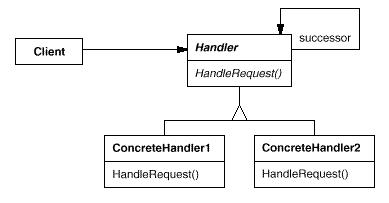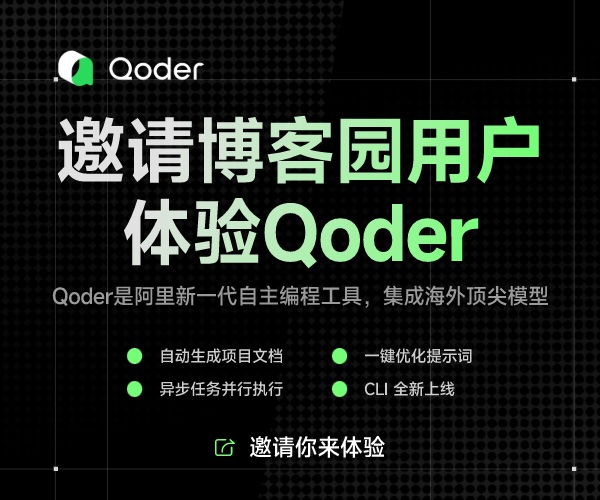使多個對象都有機會處理請求,從而避免請求的發(fā)送者和接收者之間的耦合關(guān)系,將這些對象連成一條鏈,并沿著這條鏈傳遞請求,直到有一個對象處理它為止
UML圖:

適用:
有多個的對象可以處理一個請求,哪個對象處理該請求運行時刻自動確定
你想在不明確指定接收者的情況下,向多個對象匯總的一個提交請求
可處理一個請求的對象結(jié)合應(yīng)被動態(tài)指定
 //test.h
//test.h //////////////////////////////////////////////////////////////////////////
////////////////////////////////////////////////////////////////////////// class Handler
class Handler {
{ public:
public: Handler(Handler *pSuccessor = NULL);
Handler(Handler *pSuccessor = NULL); virtual ~Handler();
virtual ~Handler();
 virtual void HandlerRequest() = 0;
virtual void HandlerRequest() = 0; protected:
protected: Handler* m_pSuccessor;
Handler* m_pSuccessor; };
};
 class ConCreateHandle1 : public Handler
class ConCreateHandle1 : public Handler {
{ public:
public: ConCreateHandle1(Handler *pSuccessor = NULL) : Handler(pSuccessor){}
ConCreateHandle1(Handler *pSuccessor = NULL) : Handler(pSuccessor){} virtual ~ConCreateHandle1(){}
virtual ~ConCreateHandle1(){}
 virtual void HandlerRequest();
virtual void HandlerRequest(); };
};
 class ConCreateHandle2 : public Handler
class ConCreateHandle2 : public Handler {
{ public:
public: ConCreateHandle2(Handler *pSuccessor = NULL) : Handler(pSuccessor){}
ConCreateHandle2(Handler *pSuccessor = NULL) : Handler(pSuccessor){} virtual ~ConCreateHandle2(){}
virtual ~ConCreateHandle2(){}
 virtual void HandlerRequest();
virtual void HandlerRequest(); };
}; // test.cpp : Defines the entry point for the console application.
// test.cpp : Defines the entry point for the console application. //
//
 #include "stdafx.h"
#include "stdafx.h" #include <iostream>
#include <iostream> #include "test.h"
#include "test.h"
 using namespace std;
using namespace std; //////////////////////////////////////////////////////////////////////////
////////////////////////////////////////////////////////////////////////// Handler::Handler(Handler *pSuccessor /* = NULL */) : m_pSuccessor(pSuccessor)
Handler::Handler(Handler *pSuccessor /* = NULL */) : m_pSuccessor(pSuccessor) {
{ }
}
 Handler::~Handler()
Handler::~Handler() {
{ delete m_pSuccessor;
delete m_pSuccessor; m_pSuccessor = NULL;
m_pSuccessor = NULL; }
}
 void ConCreateHandle1::HandlerRequest()
void ConCreateHandle1::HandlerRequest() {
{ if (NULL != m_pSuccessor)
if (NULL != m_pSuccessor) {
{ m_pSuccessor->HandlerRequest();
m_pSuccessor->HandlerRequest(); }
} else
else {
{ cout << "HandlerRequest by ConCreateHandle1\n";
cout << "HandlerRequest by ConCreateHandle1\n"; }
} }
}
 void ConCreateHandle2::HandlerRequest()
void ConCreateHandle2::HandlerRequest() {
{ // 如果m_pSuccessor被初始化了就調(diào)用他的接口,負責(zé)調(diào)用自己的接口
// 如果m_pSuccessor被初始化了就調(diào)用他的接口,負責(zé)調(diào)用自己的接口 if (NULL != m_pSuccessor)
if (NULL != m_pSuccessor) {
{ m_pSuccessor->HandlerRequest();
m_pSuccessor->HandlerRequest(); }
} else
else {
{ cout << "HandlerRequest by ConCreateHandle2\n";
cout << "HandlerRequest by ConCreateHandle2\n"; }
} }
} //////////////////////////////////////////////////////////////////////////
////////////////////////////////////////////////////////////////////////// int main(int argc, char* argv[])
int main(int argc, char* argv[]) {
{ Handler *p1 = new ConCreateHandle1;
Handler *p1 = new ConCreateHandle1; Handler *p2 = new ConCreateHandle2(p1);
Handler *p2 = new ConCreateHandle2(p1);
 p2->HandlerRequest();
p2->HandlerRequest();
 delete p2;
delete p2;
 system("pause");
system("pause"); return 0;
return 0; }
}



